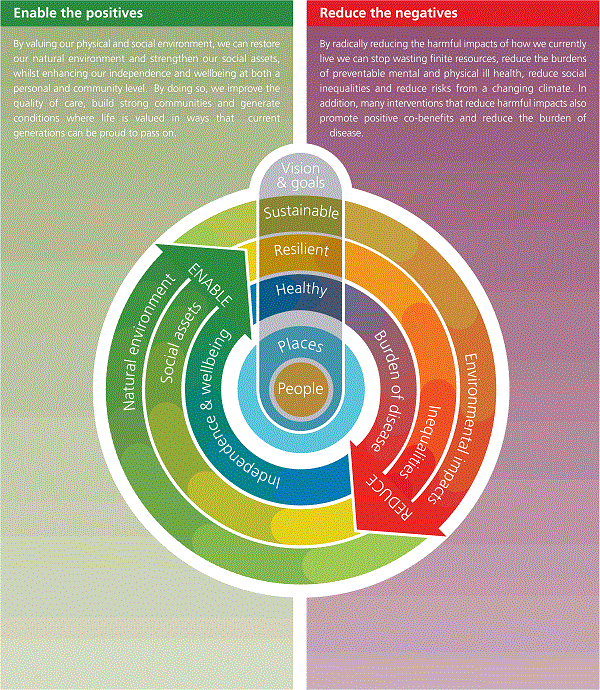2. People in Poor Health: why is it important to act?
Climate Change is recognised as the biggest public health threat this century1

Credit: ©iStock/sturti
On this page:
Threat to public health
The Sustainable Development Strategy produced by the National Health Service and Public Health England in 2014 for the health, public health and social care system notes that “Health and social care organisations are at the forefront of action to address the health impacts of climate change and need to adapt to, and prepare for, these circumstances”2. Understanding the extent of this remit requires consideration of the ways that climate change can influence health in the UK, including through impacts on patterns of disease, patterns of exposure to disease (e.g. through changes in migration) and impacts on access to the basic necessities of life3. Where people and communities already struggle to afford basic necessities there is a greater possibility ofmore severe outcomes, and increasing health inequalities4. These issues are increasingly recognised, for example one of the key messages of the recent Marmot review is that “Tackling social inequalities in health and tackling climate change must go together” 5.
Building community resilience
Preparing for extreme weather events can help with effective use of resources and building community resilience.
- Climate projections and associated analyses show that the frequency of heatwaves is increasing6. Evidence from the UK Climate Change Risk Assessment (CCRA) suggests that by the 2080s what we currently understand as a heatwave could occur most years and could even occur more than once a year in some regions. However, changes will be felt much earlier than the 2080s. Regional assessments suggest that, on average, heatwave frequency could be six times higher by the 2050s alone. The pressures on health services dealing with emergency situations will be much greater. Heatwaves often do not occur in isolation and may be associated with other events such as droughts and wildfires, which have their own health consequences.
- It is also anticipated that the emergency services will face greater pressure from expected changes in the frequency of flood events. Estimates from the CCRA suggest a further 0.9 to 2.3 million people could be at significant risk of river flooding by the 2080s resulting in more than doubling of the effort required by the emergency services without taking account of any change in costs associated with responding to more severe events7.
- The financial costs associated with events are difficult to estimate, and do not take account of the full impacts on health and wellbeing that occur. Although costing tools exist, these are controversial and must be used with caution. Indeed, there are strong arguments pointing to fundamental flaws in current costing methods from the perspective of rebalancing inequalities – a key aim of the recent Sustainable Development Strategy. Costing methodologies can place lower values on the health impacts of those least responsible and most impacted by the effects of climate change – the poor and future generations – so that those who are worst affected count least. It is also important to consider that it is not always the funder of responses who is the beneficiary of savings.
- See the Further Resources section for more information.
Duties and responsibilities
Local authorities and their partners in health and social care have statutory duties and other responsibilities in relation to the protection of people’s health. For instance:
- The Health and Social Care Act 2012 puts local authorities at the centre of activities to improve health, with public health now brought into local government. This brings together the work of the NHS with those providing social care, housing, environmental health, leisure and transport services. The Act puts new duties on clinical commissioning groups to have regard to the need to reduce inequalities in benefits which can be obtained from health services including both NHS and public health functions. Important instruments for joining up actions to address climate risks and extreme weather events are the Joint Strategic Needs Assessments (JSNAs) and the associated strategies produced by Health and Wellbeing Boards. Health and Wellbeing Boards also have a duty to encourage health and care commissioners to work together to enhance the health and wellbeing of people in their area.
- The Equality Act 2010 allows for positive action in favour of people in groups with protected characteristics. Protected characteristics include disabilities defined as “physical or mental impairment that has a ‘substantial’ and ‘long-term’ negative effect on normal day-to-day tasks”.
- The Civil Contingencies Act 2004 identifies local authorities, along with the emergency services and NHS bodies as the key organisations who have a responsibility for developing plans for emergency situations. There is an explicit responsibility for helping ‘people who are less able to help themselves in the circumstances of an emergency’ by planning for the potential effects of an emergency, warning and informing both before and during events and facilitating support which can be provided through the commercial and voluntary sectors.8 Partnership working is given a strong emphasis and there is a requirement to work with other organisations in local resilience fora to develop responses to support civil protection.
- The National Flood Emergency Framework provides a central reference point to assist local authorities and their partners in service delivery to work together to plan for flood events.9 It provides a number of core information resources, guidance on key actions such as interpreting flood warnings and communications and case studies from recent flood events.
- The Heatwave Plan for England is non-statutory but provides a basis through which other obligations to produce adaptation plans can be developed. Its main purpose is to provide information which helps in the process of building more resilient communities to heatwaves. It sets out ways to prepare for heatwave events and what to do to avoid some of the most severe impacts from prolonged exposure to high temperatures. Raising awareness among the wider public is one important goal. It also highlights the role of local NHS, public health and social care organisations in overseeing the care of people with particular susceptibilities, to help reduce the potential for over-exposure and to help ensure that service provision is sufficiently resilient to cope with the challenges associated with heatwaves.
- Action on reducing health and social inequalities is central to the Sustainable Development Unit (SDU) for NHS England and Public Health England’s recent Sustainable Development Strategy10 (Figure 1). The strategy is an important reference point for actions in relation to statutory responses. The SDU also provides additional guidance on statutory and policy drivers for action.11

Figure 3: The foundation for creating a virtuous cycle for achieving ‘sustainable, resilient, healthy places and people.12
References
- Anthony Costello, Mustafa Abbas, Adriana Allen, Sarah Ball, Sarah Bell, Richard Bellamy, Sharon Friel, Nora Groce, Anne Johnson, Maria Kett, Maria Lee, Caren Levy, Mark Maslin, David McCoy, Bill McGuire, Hugh Montgomery, David Napier, Christina Pagel, Jinesh Patel, Jose Antonio Puppim de Oliveira, Nanneke Redclift, Hannah Rees, Daniel Rogger, Joanne Scott, Judith Stephenson, John Twigg, Jonathan Wolff, Craig Patterson (2009) The Lancet 373: 1693–733
- NHS Sustainable development Unit (2012) Adaptation to Climate Change for Health and Social care organisations “Co-ordinated, Resilient, Prepared”. Page 3
- Sotiris Vardoulakis and Clare Heaviside, The Health Effects of Climate Change in the UK, 2012, Health Protection Agency.
- Anthony Costello, Mustafa Abbas, Adriana Allen, Sarah Ball, Sarah Bell, Richard Bellamy, Sharon Friel, Nora Groce, Anne Johnson, Maria Kett, Maria Lee, Caren Levy, Mark Maslin, David McCoy, Bill McGuire, Hugh Montgomery, David Napier, Christina Pagel, Jinesh Patel, Jose Antonio Puppim de Oliveira, Nanneke Redclift, Hannah Rees, Daniel Rogger, Joanne Scott, Judith Stephenson, John Twigg, Jonathan Wolff, Craig Patterson (2009) The Lancet 373: 1693–733
- The Marmot Review Team (2010) Fair society, healthy lives.The Marmot Review. Page 9.
- Defra (2012) UK Climate Change Risk Assessment: Evidence Report, London
- Defra (2012) UK Climate Change Risk Assessment: Evidence Report, London
- Civil Contigencies Secretariat (2008) Identifying People Who Are Vulnerable in a Crisis: Guidance for Emergency Planners and Responders.
- Defra (2013) The National Flood Emergency Framework for England.
- Public Health England and the Sustainable Development Unit for NHS England (2014) Sustainable, Resilient, Healthy People & Places A Sustainable Development Strategy for the NHS, Public Health and Social Care system
- Public Health England and the Sustainable Development Unit for NHS England (2014) Statutory and Policy Drivers for Change presentation
- Public Health England and the NHS Sustainable Development Unit (2014) Sustainable, Resilient, Healthy People & Places. A Sustainable Development Strategy for the NHS, Public Health and Social Care system

Built by:

© 2014 - Climate Just
Contact us
